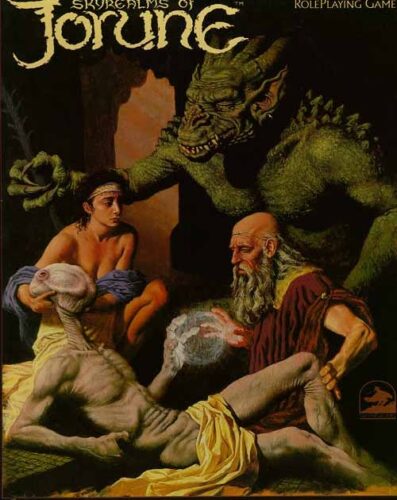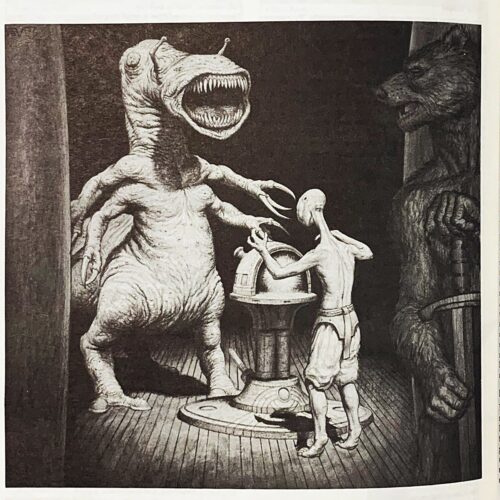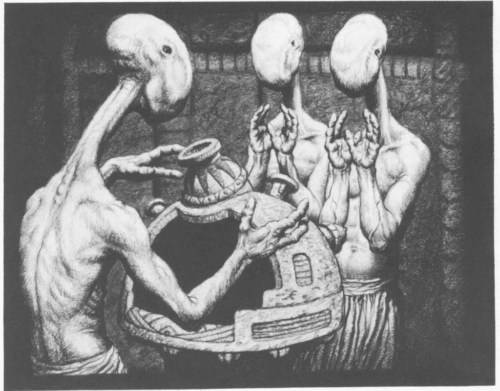I am in the middle of a writing project (Twilight Invasion, if you must know) but this just means I have extra procrastination for other writing projects. I’ve written about Jorune before. There’s some activity on the Jorune Facebook page for a resurgence into the BRP version but honestly I don’t think I can face rolling a d100 again. It’s too heartbreaking.
From Wikipedia
“Skyrealms of Jorune was based on a science-fantasy background (of the planetary romance subtype) created by Andrew Leker, initially for a school writing assignment. The setting was somewhat comparable to the Barsoom of the John Carter novels of Edgar Rice Burroughs, in that it was a barbaric fantasy world populated by sword-wielding heroes who encountered strange alien beings and technologies.”
What appeals with Jorune?
Jorune is a multi-layered tale. Humanity is shipwrecked and orphaned. An indigenous alien, possessed of dangerous quasi-magical species is passive and hostile. Complex narratives on bio-engineering and the sanctity of nature versus colonialism and cultural integration. And an amazing community of creators and Gas who have put together so much more than was originally envisioned.
What’s less appealing with Jorune?
The older rules sets are awful but the real elephant in the room is the status of the intellectual property itself. It’s been handed from pillar to post – the old creators aren’t interested and don’t seem to be friends and it’s languished for decades in a perpetual no-mans land.
Soooo…
So, I figured why not do what I’ve been doing with many of my other games and convert Jorune. Or at least provide a model for it.
Background
I can’t help you much here. There’s plenty of materials out there for learning more about Jorune. You can also still buy the older Jorune rules from Chessex.com which, frankly, I would buy again just to make sure I had a copy. The rules are outdated; the content is gold.
Over a thousand years ago, humans arrived on the planet Jorune and came into contact with the native Shantha. Jorune had had at least one previous colonisation attempt in the past and the Shanthas reacted gracefully. However a civil war on Earth cut off contact with the humans on Jorune and in their panic, they trespassed onto Shanthic sacred lands, sparking off a violent war between humans with advanced Earthtec and Shanthas with their devastating Dyshas. Everyone lost that war and the Shanthas retreated into a seclusion as a dying race.
Jorune is a unique world due to the ambient energy that flows through and around the planet, called Isho. According to the Shanthic religion, each type of Isho has a colour which they associate with the moons of Jorune and with the different capabilities of the Isho forms. Some can be used to hurt, some to heal and some to form shields or create warp gates. The Skyrealms, for which Jorune is most famous, are floating islands which move above the land on currents of Isho, held aloft by naturally occurring crystals which focus the Isho stream into movement. Isho is the fuel for Dyshas and dyshas are strongest in areas with high Isho flow.
The game is set much later when humans have settled into Jorune as their permanent home. Their upper class, the Drenn, are selected from useful citizens who have completed Tothis (a community service). There are three breeds of humans (pure, Muadra and Boccord.) Pure humans can use Earthtec with no issues. Muadra can weave Dyshas and Boccord can interfere with Dyshas.
In essence, there are multiple races, some native, some migrant and some uplifted. Some of them (Shanthas, Crugar, Woffen and Muadra) can weave Dyshas (magic) and some of them can Interfere with Dyshas (those who have that skill are called Hishtins).
System
The system I propose is similar to the SixSimple I’ve posted about before.
Keys and Flaws
Each character chooses 5 Keys. These can be chosen from background prose, written as a list or selected in play. A sixth Key can be chosen if the player decides the character has a flaw. No, it’s not very good game balance but who said things had to be balanced? Each Key is an advantage for the player in resolving conflicts. If choosing the Key in play, you must start with at least one.
Conflicts are abstracted into multiple rounds of a blackjack-type mechanism. The first to reach or exceed 21, wins the round though players are limited in the number of cards they can spend based on what’s in their hand and how many of their Keys they can bring into the conflict.
Unopposed conflicts
If a conflict is unopposed, the Referee may still require spending of cards, needing a target number for success. 7 for easy, 14 for hard, 21 for impossible.
Opposed Conflicts
Opposed conflicts can have the same target numbers, but now you have two characters trying to achieve the target number in the least number of cards.
Making a character
The Keys chosen are important. They determine species, culture, abilities, background, strength and weaknesses, family and resources. You can’t be good at everything and a Referee must be prepared to make ruling on whether a key phrase is too broad or too narrow.
Species: This makes a good Key as it’s really identifiable. It is possible to have species as part of the description but not as a Key. This would mean they don’t get an advantage based on what they are. For example, Woffen have cultural access to a single dysha color but cannot use other colours. This is only available if Woffen is taken as a key. If it isn’t taken as a key it’s assumed this Woffen didn’t choose to study it. Similarly a Bronth character who does not take the Bronth key would be recognisable as a Bronth but would not be able to use it as an advantage.
Example 1:
Drenn Cala Borg is an attractive and imposing woman who achieved Drenn in a relatively short period of time due to the connections of her family. Despite the accusations of nepotism within the Drenn system (which she undoubtedly benefitted from), she is highly capable, fairly skilled with the sword and has access to the family Earthtec cache. She makes friends easily and, possibly as a result of wealth, is generous to a fault.
Cala is a Human, but it’s not a Key. She’s attractive, but it’s not a Key. The words “highly capable> are too vague to be allowed as a Key. Generosity is also not a Key.
Example 2:
Hishtin Ler Mala:
- Boccord
- Cerebral
- Hishtin
- Reputation as dangerous
- Strikes fear in the heart of Dyte Punks
- Good with a spear
- Gambling Debts
Ler Mala has Boccord (larger human subspecies) as a Key so it can be used when the larger size of the Boccord subspecies is useful. He is Cerebral, proving that he’s not all brawn but implying his intelligence is academic. His key of Hishtin indicates he will have Interference abilities. Having gambling debts asa Key not only means they’re serious but people know about them.
Example 3:
Vacy Desti-Sa
Vacy is a Dyte Punk. (Vacy’s player will pick more when she feels they’re needed in the story).Vacy can choose Keys later at the Referee’s leisure. She might get into fight and choose the key “Scrapper”. She might need to squeeze into a chimney and chooses the key Contortionist. The keys chosen will indicate the type of character that Vacy’s player wants to play.
Now that you have a baseline for the character, how does the system work?
This system uses Cards for resolution (but these can be changed out for dice if you like). Each player is dealt 5 cards. The remaining cards are left in the centre as the card pool
When trying to achieve something challenging, a single card is selected from the card pool and has a face value. The player may add to this face value but explaining how their Keys help them in this situation. Any number of cards up to the maximum may be used but when used these are lost until the Referee moves to the next scene.
Example 4:
Vacy is angry at Ler Mala and fires a Desti dysha. Her player pulls a card from the pool, getting a 7. Ler Mala’s player pulls a 6 from the pool but not wanting to take a hit, decides to go all in with Hishtin and Strikes Fear into the Heart of Dyte Punks. This allows Ler Mala’s player to select two cards from his hand and add them to the pile. He choose a 4 and a 3 from his hand. They’re low value but they push his score up to 13. Vacy can still win though and adds her Dyte Punk keyphrase card – choosing a 10 from her hand and bringing her score to 17. She wins! She describes how a Desti bolt catches Ler off guard and knocks him off his feet. With no alternative in mind (and feeling a little foolish for being arrogant), Ler Mala takes a Dysha hit and loses 1 card from his hand. He’s down to 2 cards now, while Vacy has 4 in her hand, severely hampering his ability to retaliate. However, as Vacy’s player hasn’t chosen her extra Keyphrases, she’s can’t play her cards this scene unless the Referee allows her to take another keyphrase mid-fight. She watches as Ler Mala clambers to his feet, dusts himself off and inspects the scorch marks on his tunic. Ler Mala shouts “Right, you’re dead” in an attempt to intimidate. He argues his Strikes Fear and Dangerous reputation allow him to use the last two cards, two 8s, in his hand. He pulls a third card from the pool, a 7. This pushes him over the 21 he needs for an absolute success. Vacy is intimidated and decides to run for it….
Flaws are something that can be taken advantage of by other players. They can choose any opposing card which is relevant to their Keys and completely remove one card of their choosing from the deck without having to play a card.
Example 5:
Drenn Cala Borg has an advantage over Ler Mala because she has a Wealth key and he has Gambling Debt. Without playing a card, she can manipulate him and remove one of the cards he has in play without sacrificing a card in her hand. How this is done must be role-played.
Resetting Your Hand
The Referee will let players know when they can refresh their hand from the pool. Injuries still represent a loss of a card from the hand.
Example 6:
At the end of the Scene above, Vacy and Ler Mala are allowed to refresh their hand from the Pool. Vacy is allowed to have all of her cards back, Ler Mala’s hand is still reduced by 1 due to the Desti bolt injury he received. Until he gets that healed, he’s going to be at a disadvantage.
Advancement
There are two tracks for advancement within Jorune: Social and Personal.
Social Advancement comes from gaining Marks which, when they reach a certain level, allow a person to progress from Tauther (the term for someone trying to achieve Tothis) to Drenn. Marks are received by doing services for Drenn and impressing them enough that they will mark the Challisk of the character. In game, Challisk marks can be hoarded until the character completes Tothis and becomes Drenn or they may be spent as social currency. A Mark may be traded for a favour. A Referee has final say on this but it can be used to influence success on a challenge as well.
Example 7:
While she was still Tauther, Cala Borg needed help as she had been tasked with helping remove a stubborn tree by a Drone. She bargained with another farmer, to use his farm animals as lifters. She sacrificed a Mark for this, rationalising that she would get it back but also all of her group would still get their Marks. A net gain for the party.
Personal Advancement comes from receiving 1-2 points for advancement: one for experience and one for role-playing. The roleplaying is based on the assessment of other players. The Referee asks the players: Who roleplayed well? If a player is mentioned, they get a point. The second point, for experience, comes from the Referee asking the players themselves: What have you learned? This can be from successes or mistakes.
When they have the Personal points, they can use them to be improve their chances of success.
- 10 points will increase the hand of the player by 1.
- 5 points will allow the selection of a new Key or buy off their Flaw.
- Personal points can be used in game to allow the player to refresh their hand (1 point = 1 card).
Isho
Isho is a Shanthic concept for life and breath. It’s generated by the planets crystal core (similar to the ferrous magnetic core of Earth). Native species on Jorune use Isho as naturally as breathing but even non-jorunn species can be sensitive to it.
There are seven Colors of Isho in the Shanthic religion.
- Desti – Red – Isho related to electricity and lightning
- Du – Orange – Isho related to heat and light
- Ebba – Yellow – Isho related to force and motion
- Gobey – Black – Isho related to shields, solidity
- Launtra – Green – Isho related to healing
- Shal – Blue – Isho related to minds and nerves
- Tra – White – Isho related to warps
There are three other abilities which are relevant.
Tra-Sense – possessed by Shanthas, Muadra, Woffen, Crugar and most native species. this is the ability to see Isho ripples – including the shape of the land, the Color of others and perceive the world. Tran sense does not need light and it offers a 360º perception of the world.
Signature – possessed by Shanthas, Boccord and Bronth. This allows the user to see Isho use, including the ripples within an individual. It can tell the user when someone is preparing to use a Dysha, and what the dysha is.
Interference – possessed by Boccord and Humans. This ability allows the user to attempt to unweave any dysha they can perceive.
Shanthas and Muadra have access to all Dyshas. Dyshas are Isho-constructs that use the colour Isho to affect the world. A Desti dysha might be a lightning bolt, a Du dysha could be used to heat soup. Dyshas commonly have three shapes – auras, orbs and bolts.
Crugar have access to Desti bolt dyshas and Woffen have access to Ebba orb dyshas (but only if they have taken the appropriate Key)
A Muadra (with that as their key) has access to any dysha from any Color but that single card draw alone may not be enough for them. To get better at the individual Colors, they have to take them as Keys.
Example 8:
Vacy is a Dyte Punk (a subculture of Muadra society). After a few more gaming sessions, she has chosen the keys Scrapper and Thief (which both reflect her character idea). She wants to get good at Desti and Tra dyshas ands the Referee rationalise that she has found a teacher and is permitted to take them as Keys. She just got a whole lot more dangerous. She can use three cards when using a Desti lightning bolt but also combining Tra means an extra card is used and can literally shoot thorough walls.
Regaining Isho
The advantage of Natural Isho for Shanthas and Muadra is that even after they have exhausted their cards, they may replenish their hand by spending their turn “gathering” Isho. Each turn, they gain one card back. Knowing your enemy is important as the Caji (Shanthic term for a Dysha user) is vulnerable during this time.
Isho Storms
Isho flows across the planet like weather and Isho storms are when a large concentration of Isho pours through a place. Depending on the Color of the storm, this can cause spontaneous dyshas which is dangerous but Muadra (including Caji, Copra and Dytes) have to be careful. During an Isho Storm, the referral may ask the player to make an unopposed challenge on the strength of the storm (usually 21). If the player fails, they and anyone near them (within 10 metres0 take a hit (losing one card from their hand due to injury). This hit can be healed using Launtra auras and orbs. If the storm is still raging an hour later, they make need to make another.
Crystals
Crystals store Isho belonging to one Color. If a Caji has a Desti crystal, they can expend it and get an extra free Pool Draw when using Desti dyshas. Once it’s gone, it has to be recharged.



